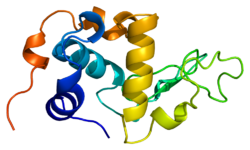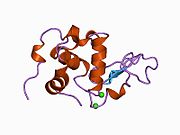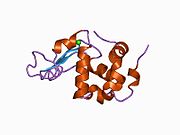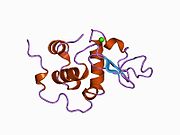| LALBA | |||||||||||||||||||||||||||||||||||||||||||||||||||
|---|---|---|---|---|---|---|---|---|---|---|---|---|---|---|---|---|---|---|---|---|---|---|---|---|---|---|---|---|---|---|---|---|---|---|---|---|---|---|---|---|---|---|---|---|---|---|---|---|---|---|---|
 | |||||||||||||||||||||||||||||||||||||||||||||||||||
| |||||||||||||||||||||||||||||||||||||||||||||||||||
| Identifiers | |||||||||||||||||||||||||||||||||||||||||||||||||||
| Aliases | LALBA, entrez:3906, LYZG, lactalbumin alpha, HAMLET | ||||||||||||||||||||||||||||||||||||||||||||||||||
| External IDs | OMIM: 149750 MGI: 96742 HomoloGene: 1720 GeneCards: LALBA | ||||||||||||||||||||||||||||||||||||||||||||||||||
| |||||||||||||||||||||||||||||||||||||||||||||||||||
| |||||||||||||||||||||||||||||||||||||||||||||||||||
| |||||||||||||||||||||||||||||||||||||||||||||||||||
| |||||||||||||||||||||||||||||||||||||||||||||||||||
| |||||||||||||||||||||||||||||||||||||||||||||||||||
| Wikidata | |||||||||||||||||||||||||||||||||||||||||||||||||||
| |||||||||||||||||||||||||||||||||||||||||||||||||||
α-Lactalbumin, also known as LALBA, is a protein that in humans is encoded by the LALBA gene.[5][6][7]
Overview[edit]
α-Lactalbumin is a protein that regulates the production of lactose in the milk of almost all mammalian species.[8] In primates, α-lactalbumin expression is upregulated in response to the hormone prolactin and increases the production of lactose.[9]
α-Lactalbumin forms the regulatory subunit of the lactose synthase (LS) heterodimer and β-1,4-galactosyltransferase (beta4Gal-T1) forms the catalytic component. Together, these proteins enable LS to produce lactose by transferring galactose moieties to glucose. As a multimer, α-lactalbumin strongly binds calcium and zinc ions and may possess bactericidal or antitumor activity. A folding variant of human α-lactalbumin that may form in acidic environments such as the stomach, called HAMLET, probably induces apoptosis in tumor and immature cells.[5] The corresponding folding dynamics of α-lactalbumin is thus highly unusual.[10]
When formed into a complex with Gal-T1, a galactosyltransferase, α-lactalbumin, enhances the enzyme's affinity for glucose by about 1000 times, and inhibits the ability to polymerise multiple galactose units. This gives rise to a pathway for forming lactose by converting Gal-TI to Lactose synthase.
Physical properties[edit]
The structure of α-lactalbumin is well known and is composed of 123 amino acids and 4 disulfide bridges. The molecular weight is 14178 Da, and the isoelectric point is between 4.2 and 4.5. α-Lactalbumin has two prominent forms: holo-state and apo-state. The holo-state is the natural form--folded and bound by calcium. The apo-state occurs in acidic conditions and is associated with the release of calcium ions and beta-sheet unfolding.[11] One of the main structural differences with beta-lactoglobulin is that it does not have any free thiol group that can serve as the starting-point for a covalent aggregation reaction. As a result, pure α-lactalbumin will not form gels upon denaturation and acidification. α-Lactalbumin is a Ca2+ binding protein with a single strong calcium binding spot seen below. The calcium binds to the carboxylic groups of three aspartate residues (Asp 82, 87, 88), seen in blue and to the carbonyl groups from lysine 79 and aspartate 84, seen in purple. This binding is coordinated by two water molecules (red). These residue binding sites are conserved among most species containing α-lactalbumin.[11]
Evolution[edit]
The sequence comparison of α-lactalbumin shows a strong similarity to that of lysozymes, specifically the Ca2+-binding c-lysozyme.[12] These two proteins share much of their physical structure but contain less than half of the same amino acid sequence and therefore vary in function drastically.[11] So, the expected evolutionary history is that gene duplication of the c-lysozyme was followed by mutation, resulting in the loss of lysozyme catalytic activity in α-lactalbumin.[8][13] This gene predates the last common ancestor of mammals and birds, which probably puts its origin at about 300 Ma.[14]
Functions[edit]
Current research is finding new application of α-lactalbumin outside the physiological lactose production.
Nutrition: α-Lactalbumin is essential for newborn nutrition. This protein provides essential amino acids and bioactive compounds necessary for optimal growth, development, and health. α-Lactalbumin is the most abundant whey protein in human milk and its properties have been researched to include in infant formulas to replicate mammary milk compounds. This protein is a strong source of branched amino acids, cysteine, and tryptophan residues, each with correlated health benefits.[15]
Clinical Uses: α-Lactalbumin has been researched in conjunction with many different medical conditions and is thought to correlate with positive outcomes. Many of these benefits are due to the bioactive compounds it is made of and the protein’s ability to bind complexes.[13]
PCOS: Polycystic Ovary Syndrome (PCOS) is one disease that higher levels of α-lactalbumin have been linked with relieving symptoms. This condition is closely linked with gut dysbiosis caused by inflammation of the intestinal lining and a microbiota imbalance. α-Lactalbumin promotes healthy bacterial strains such as Lactobacillus acidophilus, Bifidobacterium short, and Bifidobacterium longum. These bacteria produce short chain fatty acids (SCFA) which improve the gut biome. In a controlled study, the group that ate a diet higher in α-lactalbumin experienced a decrease in symptoms associated with PCOS, and higher levels of healthy bacteria. While there isn’t a cure for this condition, this could be a short-term remedy.[16]
Mental health: α-Lactalbumin is a source of amino acids which are connected to improved mental health. This protein is rich in Tryptophan residues which are a precursor to serotonin, a neurotransmitter associated with positive moods. The protein also increases the plasma concentration for other large neutral amino acids (LNAAs) which help balance hormones. The cysteine residues aid in glutathione synthesis which is an important antioxidant.[15][16]
Cancer: There has been extensive research on apoptotic effects that α-lactalbumin potentially has when it forms a complex with oleic acid called HAMLET (Human alpha-lactalbumin made lethal to tumor cells). This HAMLET complex disrupts the structure of the membrane when bound, promoting cell death to protect the integrity of the organism. This complex can translocate into the nuclei of cancerous cells, but not of healthy cells. When in cancer cells, this protein-OA complex has been shown to slow the progression of tumors in numerous studies. α-Lactalbumin's native state does not show these same anti-cancer functions, so it is likely that the oleic acid expresses the apoptotic functions while the α-lactalbumin is responsible for targeting the specific cells lines such as colon, bladder, and glioblastoma cancer cells.[13]
References[edit]
- ^ a b c GRCh38: Ensembl release 89: ENSG00000167531 – Ensembl, May 2017
- ^ a b c GRCm38: Ensembl release 89: ENSMUSG00000022991 – Ensembl, May 2017
- ^ "Human PubMed Reference:". National Center for Biotechnology Information, U.S. National Library of Medicine.
- ^ "Mouse PubMed Reference:". National Center for Biotechnology Information, U.S. National Library of Medicine.
- ^ a b "Entrez Gene: LALBA lactalbumin, alpha-".
- ^ Hall L, Davies MS, Craig RK (January 1981). "The construction, identification and characterisation of plasmids containing human alpha-lactalbumin cDNA sequences". Nucleic Acids Research. 9 (1): 65–84. doi:10.1093/nar/9.1.65. PMC 326669. PMID 6163135.
- ^ Hall L, Emery DC, Davies MS, Parker D, Craig RK (March 1987). "Organization and sequence of the human alpha-lactalbumin gene". The Biochemical Journal. 242 (3): 735–742. doi:10.1042/bj2420735. PMC 1147772. PMID 2954544.
- ^ a b Qasba PK, Kumar S (1997). "Molecular divergence of lysozymes and alpha-lactalbumin". Critical Reviews in Biochemistry and Molecular Biology. 32 (4): 255–306. doi:10.3109/10409239709082574. PMID 9307874.
- ^ Kleinberg DL, Todd J, Babitsky G (July 1983). "Inhibition by estradiol of the lactogenic effect of prolactin in primate mammary tissue: reversal by antiestrogens LY 156758 and tamoxifen". Proceedings of the National Academy of Sciences of the United States of America. 80 (13): 4144–4148. Bibcode:1983PNAS...80.4144K. doi:10.1073/pnas.80.13.4144. PMC 394217. PMID 6575400.
- ^ Bu Z, Cook J, Callaway DJ (September 2001). "Dynamic regimes and correlated structural dynamics in native and denatured alpha-lactalbumin". Journal of Molecular Biology. 312 (4): 865–873. doi:10.1006/jmbi.2001.5006. PMID 11575938.
- ^ a b c Permyakov EA (August 2020). "α-Lactalbumin, Amazing Calcium-Binding Protein". Biomolecules. 10 (9): 1210. doi:10.3390/biom10091210. PMC 7565966. PMID 32825311.
- ^ Acharya KR, Stuart DI, Walker NP, Lewis M, Phillips DC (July 1989). "Refined structure of baboon alpha-lactalbumin at 1.7 A resolution. Comparison with C-type lysozyme". Journal of Molecular Biology. 208 (1): 99–127. doi:10.1016/0022-2836(89)90091-0. PMID 2769757.
- ^ a b c El-Fakharany EM, Redwan EM (November 2019). "Protein-lipid complexes: molecular structure, current scenarios and mechanisms of cytotoxicity". RSC Advances. 9 (63): 36890–36906. Bibcode:2019RSCAd...936890E. doi:10.1039/C9RA07127J. PMC 9075609. PMID 35539089.
- ^ Prager EM, Wilson AC (1988). "Ancient origin of lactalbumin from lysozyme: analysis of DNA and amino acid sequences". Journal of Molecular Evolution. 27 (4): 326–335. Bibcode:1988JMolE..27..326P. doi:10.1007/BF02101195. PMID 3146643. S2CID 10039589.
- ^ a b Almeida CC, Mendonça Pereira BF, Leandro KC, Costa MP, Spisso BF, Conte-Junior CA (2021-05-14). Spigno G (ed.). "Bioactive Compounds in Infant Formula and Their Effects on Infant Nutrition and Health: A Systematic Literature Review". International Journal of Food Science. 2021: 8850080. doi:10.1155/2021/8850080. PMC 8140835. PMID 34095293.
- ^ a b Cardinale V, Lepore E, Basciani S, Artale S, Nordio M, Bizzarri M, Unfer V (August 2022). "Positive Effects of α-Lactalbumin in the Management of Symptoms of Polycystic Ovary Syndrome". Nutrients. 14 (15): 3220. doi:10.3390/nu14153220. PMC 9370664. PMID 35956395.
Further reading[edit]
- Heine WE, Klein PD, Reeds PJ (March 1991). "The importance of alpha-lactalbumin in infant nutrition". The Journal of Nutrition. 121 (3): 277–283. doi:10.1093/jn/121.3.277. PMID 2002399.
- Permyakov EA, Berliner LJ (May 2000). "alpha-Lactalbumin: structure and function". FEBS Letters. 473 (3): 269–274. doi:10.1016/S0014-5793(00)01546-5. PMID 10818224. S2CID 83964232.
- Hall L, Emery DC, Davies MS, Parker D, Craig RK (March 1987). "Organization and sequence of the human alpha-lactalbumin gene". The Biochemical Journal. 242 (3): 735–742. doi:10.1042/bj2420735. PMC 1147772. PMID 2954544.
- Davies MS, West LF, Davis MB, Povey S, Craig RK (July 1987). "The gene for human alpha-lactalbumin is assigned to chromosome 12q13". Annals of Human Genetics. 51 (3): 183–188. doi:10.1111/j.1469-1809.1987.tb00869.x. PMID 3479943. S2CID 37901087.
- Findlay JB, Brew K (May 1972). "The complete amino-acid sequence of human -lactalbumin". European Journal of Biochemistry. 27 (1): 65–86. doi:10.1111/j.1432-1033.1972.tb01812.x. PMID 5049057.
- Hall L, Craig RK, Edbrooke MR, Campbell PN (June 1982). "Comparison of the nucleotide sequence of cloned human and guinea-pig pre-alpha-lactalbumin cDNA with that of chick pre-lysozyme cDNA suggests evolution from a common ancestral gene". Nucleic Acids Research. 10 (11): 3503–3515. doi:10.1093/nar/10.11.3503. PMC 320727. PMID 6285305.
- Håkansson A, Zhivotovsky B, Orrenius S, Sabharwal H, Svanborg C (August 1995). "Apoptosis induced by a human milk protein". Proceedings of the National Academy of Sciences of the United States of America. 92 (17): 8064–8068. Bibcode:1995PNAS...92.8064H. doi:10.1073/pnas.92.17.8064. PMC 41287. PMID 7644538.
- Stacey A, Schnieke A, Kerr M, Scott A, McKee C, Cottingham I, et al. (March 1995). "Lactation is disrupted by alpha-lactalbumin deficiency and can be restored by human alpha-lactalbumin gene replacement in mice". Proceedings of the National Academy of Sciences of the United States of America. 92 (7): 2835–2839. Bibcode:1995PNAS...92.2835S. doi:10.1073/pnas.92.7.2835. PMC 42313. PMID 7708733.
- Fujiwara Y, Miwa M, Takahashi R, Hirabayashi M, Suzuki T, Ueda M (June 1997). "Position-independent and high-level expression of human alpha-lactalbumin in the milk of transgenic rats carrying a 210-kb YAC DNA". Molecular Reproduction and Development. 47 (2): 157–163. doi:10.1002/(SICI)1098-2795(199706)47:2<157::AID-MRD5>3.0.CO;2-L. PMID 9136116. S2CID 43232515.
- Lindner RA, Kapur A, Carver JA (October 1997). "The interaction of the molecular chaperone, alpha-crystallin, with molten globule states of bovine alpha-lactalbumin". The Journal of Biological Chemistry. 272 (44): 27722–27729. doi:10.1074/jbc.272.44.27722. PMID 9346914.
- Giuffrida MG, Cavaletto M, Giunta C, Neuteboom B, Cantisani A, Napolitano L, et al. (November 1997). "The unusual amino acid triplet Asn-Ile-Cys is a glycosylation consensus site in human alpha-lactalbumin". Journal of Protein Chemistry. 16 (8): 747–753. doi:10.1023/A:1026359715821. PMID 9365923. S2CID 42107172.
- Chandra N, Brew K, Acharya KR (April 1998). "Structural evidence for the presence of a secondary calcium binding site in human alpha-lactalbumin". Biochemistry. 37 (14): 4767–4772. doi:10.1021/bi973000t. PMID 9537992.
- Håkansson A, Andréasson J, Zhivotovsky B, Karpman D, Orrenius S, Svanborg C (February 1999). "Multimeric alpha-lactalbumin from human milk induces apoptosis through a direct effect on cell nuclei". Experimental Cell Research. 246 (2): 451–460. doi:10.1006/excr.1998.4265. PMID 9925761.
- Svensson M, Sabharwal H, Håkansson A, Mossberg AK, Lipniunas P, Leffler H, et al. (March 1999). "Molecular characterization of alpha-lactalbumin folding variants that induce apoptosis in tumor cells". The Journal of Biological Chemistry. 274 (10): 6388–6396. doi:10.1074/jbc.274.10.6388. PMID 10037730.
- Harata K, Abe Y, Muraki M (March 1999). "Crystallographic evaluation of internal motion of human alpha-lactalbumin refined by full-matrix least-squares method". Journal of Molecular Biology. 287 (2): 347–358. doi:10.1006/jmbi.1999.2598. PMID 10080897.
- Last AM, Schulman BA, Robinson CV, Redfield C (August 2001). "Probing subtle differences in the hydrogen exchange behavior of variants of the human alpha-lactalbumin molten globule using mass spectrometry". Journal of Molecular Biology. 311 (4): 909–919. doi:10.1006/jmbi.2001.4911. PMID 11518539.
- Bai P, Peng Z (November 2001). "Cooperative folding of the isolated alpha-helical domain of hen egg-white lysozyme". Journal of Molecular Biology. 314 (2): 321–329. doi:10.1006/jmbi.2001.5122. PMID 11718563.
- Andrews P (August 1970). "Purification of lactose synthetase a protein from human milk and demonstration of its interaction with alpha-lactalbumin". FEBS Letters. 9 (5): 297–300. doi:10.1016/0014-5793(70)80382-9. PMID 11947697. S2CID 23041445.
External links[edit]
- alpha-Lactalbumin at the U.S. National Library of Medicine Medical Subject Headings (MeSH)
- Human LALBA genome location and LALBA gene details page in the UCSC Genome Browser.









